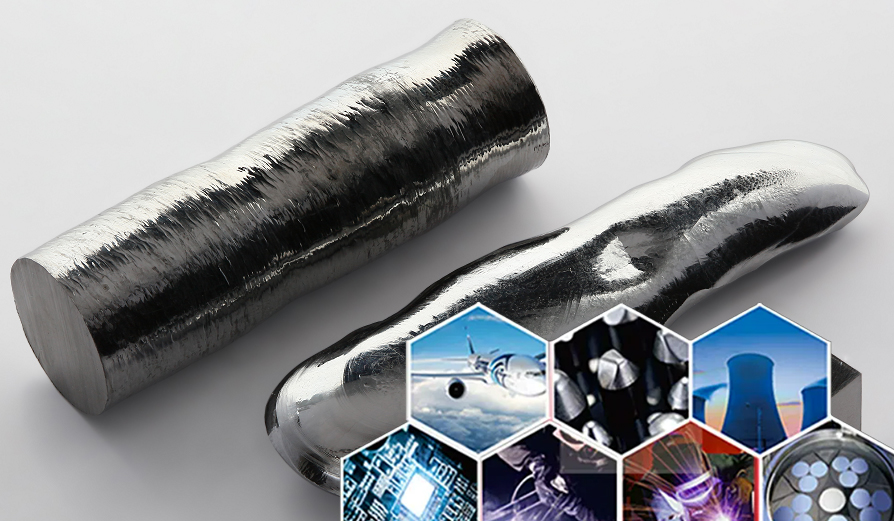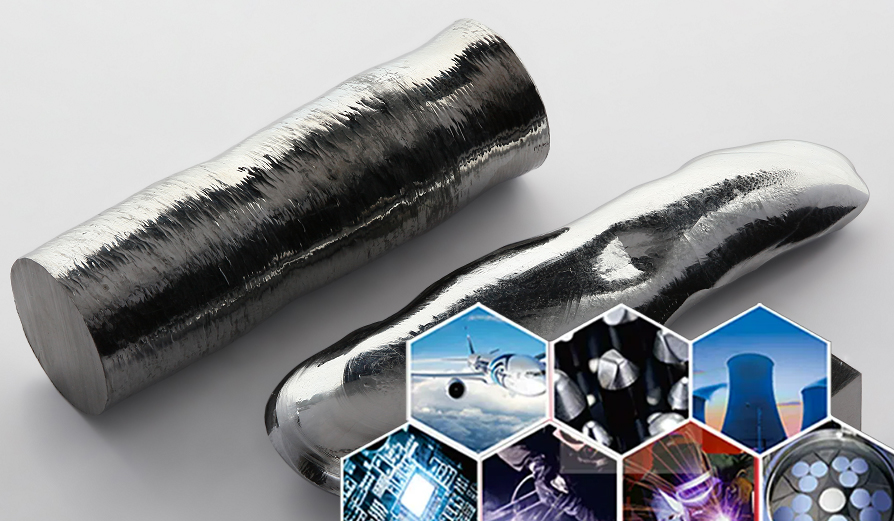Manufacturing and Applications of Rhenium Metals and Alloys

Rhenium (Re) is prized for its exceptional high-temperature strength, corrosion resistance, and unique catalytic properties. These characteristics make rhenium and its alloys indispensable in aerospace, petrochemical refining, electronics, and nuclear applications.

1. Applications of Rhenium Metals and Alloys
1.1 High-Temperature Aerospace Components
Rhenium plays an essential role in the materials we use to build jet engines, especially in the hottest parts—like turbine blades and combustion chambers. When you add just a small amount of rhenium—typically between 3% and 6%—to nickel-based superalloys, you get a noticeable improvement in how well those materials handle extreme heat and long-term stress, also known as “creep resistance.”
In the development of turbine alloys over the years, we’ve seen this progress firsthand. Second-generation superalloys, like CMSX-4 and René N5, typically contain about 3% rhenium. That might not sound like much, but even that small fraction helps the alloy maintain its strength under punishing conditions.
Later, engineers pushed things further with third-generation superalloys like CMSX-10 and TMS-138. These materials can have as much as 6% rhenium, and they can operate at temperatures nearly 100 degrees Celsius higher than their predecessors. That’s a big leap in the world of turbine engines—higher temperatures generally mean better fuel efficiency and more thrust for the same amount of fuel.
To give you a real-world example: General Electric uses rhenium-containing alloys in its GE90 and GEnx engines, which power the Boeing 777 and 787, respectively. These engines have become industry benchmarks not just because they’re powerful, but because they’re more efficient and durable—largely thanks to the materials we’ve been discussing. Without rhenium in the mix, we simply wouldn’t be able to push modern jet engines as far as we do today.
Further reading: 6 Interesting Facts about Rhenium
1.2 Catalysis in the Petrochemical Industry
In the world of oil refining, rhenium might not be the star of the show, but it’s certainly a key player behind the scenes—especially when it comes to turning lower-grade fuels into high-octane gasoline. Rhenium is used alongside platinum to form what’s known as a bimetallic catalyst, and this pairing has proven to be far more effective than platinum alone.
The typical setup involves about 0.3% rhenium mixed with an equal amount of platinum, all supported on a base of gamma-alumina (γ-Al₂O₃). Under reforming conditions—which usually means temperatures hovering around 500 to 550 degrees Celsius and pressures reaching as high as 30 atmospheres—this catalyst helps rearrange hydrocarbon molecules to improve their octane rating.
What really makes rhenium valuable here is its knack for helping the catalyst last longer and stay cleaner. It resists the buildup of coke, that carbon gunk that tends to foul up refinery equipment over time. The result is a more stable and longer-lasting catalyst, which keeps the operation running efficiently for longer stretches.
A good example of this in action is Chevron’s Reformix process, as well as UOP’s widely used Platforming system. Both rely on platinum-rhenium catalysts to meet strict fuel standards while cutting down on hydrogen consumption—a key concern in modern refineries. Without rhenium, these processes wouldn’t be nearly as efficient or cost-effective. It’s one of those cases where a small amount of the right element can make a big difference.
Further reading: Rhenium Applications | What Is Rhenium Used for?
1.3 Electronics and Thermocouples
Rhenium’s value in electronics and temperature measurement systems comes down to two remarkable traits: its incredibly high melting point—3,186 °C—and its excellent electron emission characteristics. These properties make it a natural fit for extreme environments, where most materials would quickly degrade or fail.
Let’s start with thermocouples. In high-temperature testing—think aerospace engine development or even nuclear diagnostics—standard thermocouples just don’t cut it. But when you pair tungsten with rhenium, you get a tool that can withstand much more heat. The W-3Re/W-25Re thermocouple, for instance, can measure temperatures up to 2,300 °C. That makes it invaluable for monitoring combustion chambers, rocket engines, and other systems where temperature data has to be accurate despite extreme heat and pressure.
In electronics, rhenium is equally impressive. Its low work function means electrons can escape its surface more easily, which is exactly what you want in components like filaments and electron emitters. And because rhenium also has a very low vapor pressure—even at high temperatures—it doesn’t evaporate or degrade easily. This is especially important in high-precision instruments like X-ray devices or mass spectrometers, where long-term stability and performance are crucial.
In short, rhenium quietly powers many of the technologies that operate under conditions most materials simply can't handle. It's not always in the spotlight, but without it, a lot of modern measurement and imaging systems would fall short.
1.4 Nuclear and Defense Applications
Rhenium's ability to maintain strength under irradiation and heat makes it suitable for nuclear reactors and missile components. Molybdenum-rhenium (Mo-Re) alloys are used in superconducting magnets and nuclear instrumentation due to their radiation damage tolerance and dimensional stability.
2. Manufacturing Technologies for Rhenium and Its Alloys
2.1 Extraction and Refining
Rhenium is primarily recovered as a by-product from the roasting of molybdenite (MoS₂) concentrates during copper and molybdenum smelting.
- Global production: Approximately 54 metric tons in 2022, a 28% increase from 2021.
- Primary producers: Chile (27,000 kg), Poland (9,000 kg), United States (8,500 kg), China (3,000 kg), Uzbekistan and Kazakhstan (1,000 kg each), Armenia (350 kg).
Extraction process:
- Roasting: Molybdenite is roasted to form rhenium-containing gases (Re₂O₇).
- Absorption: Gases are absorbed in alkaline solutions.
- Precipitation: Ammonium perrhenate (NH₄ReO₄) is precipitated.
- Reduction: NH₄ReO₄ is reduced to metallic rhenium powder via hydrogen reduction at 600–800 °C.
2.2 Powder Metallurgy
Due to its high melting point, rhenium is processed mainly through powder metallurgy. Fine rhenium powder is compacted, sintered, and hot isostatically pressed (HIPed) to produce dense materials. Alloying is performed by mechanical mixing or co-reduction of mixed oxide precursors.
- Applications: W–Re alloys for thermocouples and electrodes; Mo–Re alloys for improved ductility at room temperature.
2.3 Vacuum Melting and Casting
Some rhenium alloys, particularly Mo-Re or Ni-Re alloys, are produced using vacuum arc melting (VAM) or electron beam melting (EBM). These methods prevent oxidation and contamination, ensuring high purity and uniformity.
2.4 Additive Manufacturing
Emerging technologies such as selective laser melting (SLM) and electron beam additive manufacturing (EBAM) have been investigated for fabricating rhenium components. These methods enable near-net-shape production of complex geometries and reduce material wastage.
- Example: NASA successfully printed rhenium thruster components for satellite propulsion systems using SLM, demonstrating the feasibility of additive manufacturing for rhenium parts.
3. Challenges and Future Prospects
The scarcity and cost of rhenium pose significant challenges for widespread application. Recycling from spent catalysts and scrap superalloys is becoming increasingly important. Moreover, research is ongoing to develop rhenium-free or rhenium-reduced alloys while maintaining similar high-temperature performance.
- Recycling: In 2021, approximately 25 metric tons of secondary rhenium were recovered globally, with the United States and Germany as leading recyclers.
- Price trends: Rhenium prices have fluctuated significantly, reaching over $10,000 per kg in 2008 and decreasing to around $980 per kg in 2021.
- Risk factors: Earthquakes pose a risk to rhenium production, with expected annual disruptions ranging from 0.32% to 1.32% of global capacity. Chile faces the highest seismic risk due to its significant production capacity and high seismic hazard.
Conclusion
Rhenium and its alloys hold a vital position in high-tech industries. With continuous research and development, the role of rhenium in modern engineering is poised to expand further. For more information, please visit Advanced Refractory Metals (ARM).
{{item.content}}
LEVE A REPLY
{{item.children[0].content}}
{{item.content}}






